Indexing backlinks is a crucial aspect of Google optimization that can enhance your website’s ranking in search results.
Nonetheless, this procedure may consume a considerable amount of time and may not occur automatically. In case the linked site is listed as a blocked or has low authority, the links may either be indexed belatedly or not at all.
This comprehensive guide on backlink indexing delves into the process of indexing backlinks, approaches to expedite indexing, and the most effective services to facilitate obtaining faster results and enhancing your website’s visibility in Google.
What is backlink indexing?
Backlink indexing refers to the process by which Google identifies and records links to your website that are posted on other websites. Search algorithms assess the quality and relevance of each backlink, as well as the authority of the website where it is posted.
Backlinks from authoritative and thematically relevant websites can significantly improve your ranking, while links from low-quality or spammy websites can have a negative impact on your ranking and may even result in sanctions from Google.
It is crucial to understand that indexing backlinks is a time-consuming and unpredictable process. New links can appear and disappear over time, and Google continuously updates its algorithms and backlink evaluation criteria. Therefore, it is essential to continuously monitor the quality and relevance of your backlinks and respond promptly to any changes that may affect your website’s search engine ranking.
To locate lost backlinks in Ahrefs, you can utilize the Lost Backlinks report in the backlinks section of the tool.
- Log in to your Ahrefs account.
- Go to “Site Explorer” and enter your site URL into the search bar.
- Click on the “Backlink” tab in the left sidebar.
- To see lost backlinks, click on “Lost Backlinks” on the submenu.
- You can further filter results by selecting a specific time period, backlink type, anchor text, etc. using the filter options on the page.
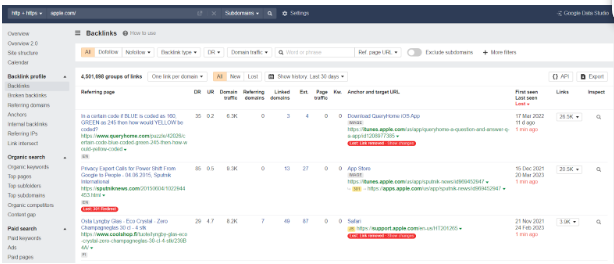
Google’s backlink indexing algorithm
Backlinks help Google understand how useful or authoritative a page is. When a page receives a significant number of backlinks, it is deemed more valuable and authoritative by Google, which can positively impact its ranking in search engine results. Google’s backlink indexing algorithm comprises various stages:
Stage 1: Link discovery.
Google’s bot begins the backlink indexing process when it detects a link to your site on another resource.
Stage 2: Analyzing page content
Google bot analyzes the content of the page to which the link leads to understand its content and determine its relevance for a specific query.
Step 3: Evaluate link quality
Google analyzes the quality and relevance of the link to determine its weight and relevance for page ranking in Google’s rankings.
Step 4: Ranking the page
After analyzing all the factors, Google determines the rank of the page the backlink links to.
How can you check if a backlink is indexed?
Verifying whether a backlink has been indexed is a crucial aspect of optimizing for Google because it helps determine the number of links that have been indexed and assess the ones that have an impact on a website’s ranking.
There are various SEO analysis tools available, such as Ahrefs and SEMrush, that enable you to monitor link indexing, as well as evaluate link quality and relevance. Using these tools, you can easily check the status of your backlinks and determine their impact on your website’s SEO performance.
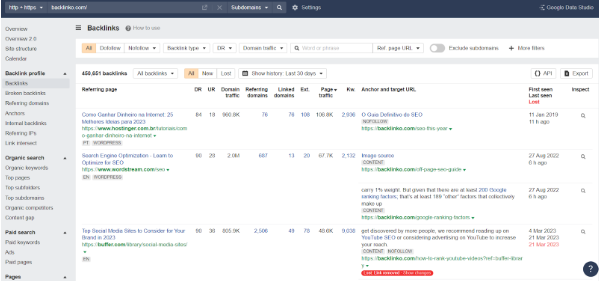
What factors affect backlink indexing?
Backlink indexing is the process by which Google finds and indexes links that lead to your site. There are several factors that can affect this process:
Factor 1: The quality and relevance of the linking site
If the linking site has high authority and is relevant to the subject matter of your site, then the link will carry more weight for Google.
Here are a few key parameters to follow to help you choose quality linking websites for backlinks:
- Domain Authority (DA): preferably, the domain authority of the linking website should be above 20 (on a 100-point scale). This is a score determined by various SEO tools that assesses the authority of a domain in search engines.
- Subject relevance: The linking website must be relevant to your niche or topic in order for the link to be considered quality.
- Search engine indexing: make sure the linking website is indexed in Google. Non-indexed sites may be of poor quality or blocked by search engines.
- No spam and unwanted content: check that the linking website does not contain spam links or malicious content, as this can have a negative impact on your site.
- Organic traffic: it is desirable that the linking website has stable organic traffic. This indicates that search engines consider the site useful and valuable to users.
- Age of the domain: old and reputable domains are usually preferred.
Factor 2: Proper use of meta tags and link attributes
To speed up the indexing process, it is important to use the right meta tags and link attributes that allow Google to understand how to process and index the link.
Below are some of the basic link meta tags and attributes that are important to use correctly:
- “title” meta tag: This meta tag is used to indicate the title of the web page and should be short, informative and contain keywords.
- The “description” meta tag: This meta tag provides a brief description of the content of the web page and is used in the snippet of search results. The description should be engaging and contain keywords related to the content.
- “robots” meta tag: This meta tag tells search engines how to index and follow the page. For example, the value “index, follow” tells Google to index the page and follow the links on it. The “noindex, nofollow” value tells Google not to index the page and not to follow the links on it.
- The “rel” attribute: This attribute is used to indicate the relationship between the current page and the destination link page. Some values of the “rel” attribute include “nofollow”, “noopener”, “noreferrer” and “sponsored”.
– “nofollow”: Tells Google not to pass link weight (PageRank) to the landing page.
– “noopener”: Denies the opening page access to the Window object of the opening page.
– “noreferrer”: Does not pass referrer information when the link is clicked.
– “sponsored”: Used to indicate that the link is sponsored or paid for.
- “hreflang” attribute: This attribute indicates the language and region of the link landing page, helping Google properly index multilingual and multi-regional sites.
- The “alt” attribute for images: Use the “alt” attribute for all images on your site to provide a text description of the image for search engines and disabled users.
Factor 3: Number and variety of links
When links are placed on diverse sites and in varying contexts, their weight and relevance to Google can increase. This demonstrates that your website is genuinely beneficial and captivating to different audiences. By diversifying your backlinks, you can establish your site’s credibility and demonstrate its usefulness across a broad range of topics and niches, which can positively impact your search engine ranking. Here are some examples of link sources:
- Industry blogs and magazines: backlinks from reputable and respected blogs and magazines in your niche demonstrate that your site provides valuable information and expertise.
- Forums and communities: active participation in industry forums and communities can lead to link placements in the context of discussions, increasing your site’s authority and credibility.
- Social media: backlinks from social media platforms can indicate that your content is popular and widely discussed, increasing your website’s visibility and reach.
- Press releases and news sites: linking to press releases and news sites can demonstrate that your website is a reliable source of relevant and important information.
- Infographics and other visuals: backlinks obtained through infographics or other visuals signify that your content is engaging and easy to follow, making your website more attractive to visitors.
- Videos and podcasts: placing links in video or podcast descriptions can attract additional traffic and increase the authority of your site.
- Reviews and product testing: backlinks from sites with reviews and product testing indicate that your site or product is worthy of attention and trust, establishing your brand as a reputable and reliable source in your industry.
The links that are most valued usually come from reputable, relevant sources with high domain authority, unique and quality content and organic traffic. It’s important to strive for a natural backlink profile by constantly developing your links and providing valuable content.
Factor 4: Freshness of content and social signals
Freshness of content and social signals will help attract more backlinks and speed up the indexing process.
- Freshness of content is a metric that reflects how relevant and relevant the content on your site is. Regularly updating content can improve a site’s visibility in search engine rankings, as Google prefers to provide users with relevant information.
- Social signals or content activity on various platforms and resources, including social media, blogs, forums, etc.
Factor 5: Technical problems on the site
If a site has technical problems, such as duplicate content, slow page loads or misconfigured meta tags, it can slow down the backlink indexing process.
Here are some of the tools and services that can help you quickly check for technical problems on your site:
- Google Search Console: This free tool from Google allows you to monitor and troubleshoot technical problems related to indexing, page loads and other aspects of the site. You’ll be able to see indexing errors, meta tags status, duplicate content, and more.
- Google PageSpeed Insights: This free tool from Google analyzes your site’s load speed and offers specific recommendations to improve performance.
- Ahrefs Site Audit: Ahrefs also offers a site audit feature that analyzes a variety of technical issues, such as slow page loads, indexing errors, and meta-tagging issues.
- SEMrush Site Audit: SEMrush offers a site audit feature that analyzes more than 130 technical parameters, including content, meta tags, site structure and performance issues. You will be provided with a report detailing the problems found and recommendations for fixing them.
- GTmetrix: GTmetrix provides detailed information about your site’s performance, including load times, traffic volume, and image optimization. You’ll also get recommendations on how to improve site speed.
- Screaming Frog SEO Spider: This is a powerful website analysis tool which can check for duplicate content, misaligned meta tags, header errors, site structure issues, and other technical issues.
Factor 6: Activity at the website
If there is no activity on a site, Google may view it as outdated and uninteresting to users, which may reduce the relevance of links to it.
Here are some examples of site activity that can affect backlink indexing:
- Frequency of content updates: Regularly adding new content or updating existing material shows search engines that the site is relevant and useful to users.
- User interaction: Comments, reviews, ratings and other forms of user interaction with the content on the site can indicate audience engagement and interest.
- Behavioral indicators: Attendance, time on site, pageview depth and bounce rate can be indicators of site activity and engagement.
- User registration and activity: If the site offers user registration or has active members, this can also be considered site activity.
The best ways to speed up backlink indexing
The faster Google indexes your backlinks, the faster you can see your site grow in the search results. Here are some of the best ways to speed up backlink indexing:
Method 1: Using link indexing services
There are various paid and free services that help speed up backlink indexing. They work by sending requests for indexing or “pinging” Google, reporting new or updated links that require indexing. This can reduce the waiting time it takes for backlinks to show up in search results and increase the visibility of your site. Some of these services are:
- IndexInject: is a paid service that promises to index most of your content within hours. It uses a network of high-quality blogs and Web sites to create additional links to your content, which promotes fast indexing.
- OneHourIndexing: this paid service also guarantees fast indexing of your links, usually within one hour. It uses various techniques such as linking to your content from other websites, sending RSS feeds, and creating webmaster notifications for indexing.
- BacklinksIndexer: This is another paid service that helps speed up backlink indexing. BacklinksIndexer uses its infrastructure to create additional links and notify search engines of your backlinks.
Method 2: Optimize your site for mobile devices
Mobile-first approach (Mobile-first) has become a staple for search engines like Google as of 2018. This means that Google indexes and evaluates the mobile version of the site first, rather than the desktop version. Consequently, optimizing your site for mobile devices is key to speeding up backlink indexing.
- Adaptive design: make sure that the site has an adaptive design that automatically scales and adapts to different screen sizes and device orientations.
- Fast page loading: optimize site page loading times by compressing images, reducing the size of scripts and styles, and using techniques such as caching and Lazy Loading.
- Ease of navigation: Simplify navigation on the mobile version of the site by providing access to all key sections and features from the home screen.
- Improve user experience: make sure that all controls on the site are easy to tap on touch screens, and that text is easy to read on small screens.
- Tests on different devices and browsers: test the site on different mobile devices, browsers, and screen resolutions to make sure it works correctly.
- Using Google tools: Use tools such as Google’s Mobile-Friendly Test and PageSpeed Insights to check your site’s mobile optimization and get recommendations for improvement.
- Implement Accelerated Mobile Pages (AMP): Consider implementing AMP, a technology developed by Google to speed up page loading on mobile devices. AMP pages are indexed faster and have a search engine optimization advantage.
Since most users use mobile devices to search for information on the Internet, Google pays a lot of attention to optimizing websites for mobile devices. Optimizing your site for mobile devices can help speed up the indexing of your links.
5 best services to speed up backlink indexing
There are many services that help speed up backlink indexing and improve your site’s ranking in Google. Some of the most popular and effective services to consider:
- IndexInject
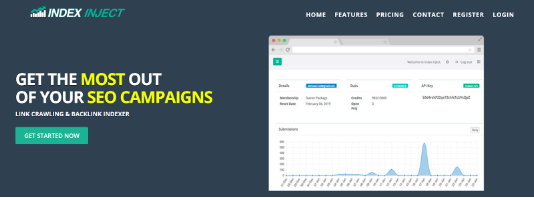
IndexInject is an online service that allows you to speed up the indexing of web pages and backlinks to them. The tool uses various techniques and methods to help Google quickly discover and index your content. It also allows you to track the indexing process and provides detailed reports on the status of indexed links.
Prices: start at $0.0025 for indexing 1 link (assuming you choose the basic $25 package, which includes indexing 10,000 links).
2. Speed-Links
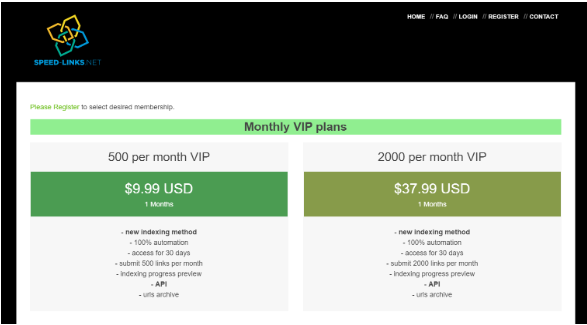
Speed-Links is a service that helps to quickly index backlinks to your site. The tool works with various search engines, including Google, Yahoo, and Bing. Speed-Links uses a combination of methods, including pinging, sitemap creation, RSS feed processing, and social signals to speed up link indexing. The service provides detailed information on the indexing status of each link and also provides reports to help you track the effectiveness of your campaign.
Rates: Includes packages starting at $9.95/month that include up to 2,500 links ($0.004 per link)
3. OneHourIndexing
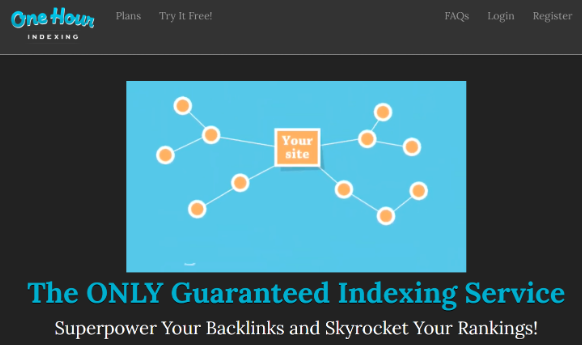
OneHourIndexing is a paid service that provides tools to speed up the backlink indexing process. As the name implies, OneHourIndexing aims to make the backlink indexing process take no more than one hour, allowing your site to quickly get the SEO benefits of new links. OneHourIndexing’s interface is intuitive and easy to use, making it accessible even to users with no SEO experience.
Pricing: The cost to index one link is about $0.017.
4. Linklicious
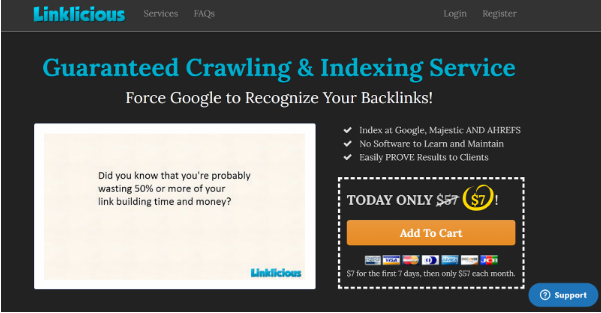
Linklicious is a paid backlink indexing service that indexes over 10 billion pages per week. This service also allows you to set up automatic indexing of new backlinks.
Prices: The basic Linklicious package costs $17 per month and includes the indexing of 50,000 links ($0.00034 per link).
5. BacklinksIndexer
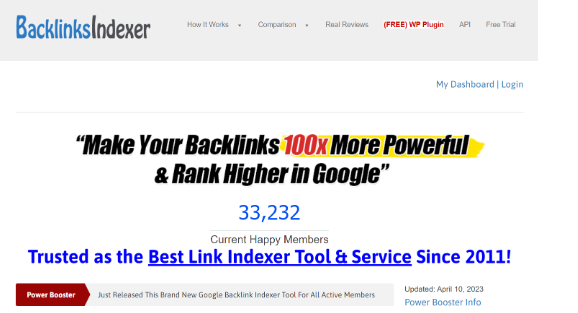
BacklinksIndexer is a paid service that provides fast backlinks indexing within hours. They use several indexing methods including ping, RSS and social signals to help ensure maximum indexing.
Prices: the basic package costs $27 per month to index 1,000 links ($0.027 per link).
Our experiment on backlink indexing
We made an experiment to compare the efficiency of four popular services of backlinks indexing
Random links placed at the same time were selected – November 1, 2022. We then analyzed the indexing results through Rush Analytics on the first day, one week later (November 7) and two weeks later (November 14). A total of 50 links for each service were analyzed.
| Indexer | Indexation cost per link | % indexation after 1 day | % indexation after 7 days | % indexation after 14 days |
| Isindexed.com | 0.20 | 52% | 74% | 78% |
| Indexmenow.com | 0.15 | 44% | 70% | 74% |
| Needmylink.com | 0.10 | 20% | 60% | 64% |
| Linkbox.pro | 0.05 | 25% | 45% | 50% |
This table shows the results of each of the four indexing services. The first column shows their URLs, the second column shows the cost of indexing per link. The third, fourth and fifth columns show the percentage of indexation after 1, 7 and 14 days, respectively.
The experiment showed different efficiency of indexing services. Based on the data obtained, we can conclude that Isindexed.com and Indexmenow.com offer a higher percentage of indexing compared to Needmylink.com and Linkbox.pro. However, you should consider the cost of indexing and your budget when choosing a service.
If you have any questions about the process of indexing backlinks, we will be happy to answer them during a free consultation.
